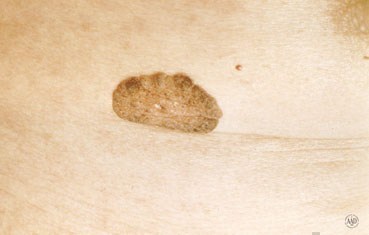Seborrheic Keratoses

Seborrheic keratosis: This non-cancerous growth can grow quite thick and have a warty surface.
Seborrheic keratosis (seb-o-REE-ik care-uh-TOE-sis) is a common skin growth. It may look worrisome, but it is benign (not cancer). These growths often appear in middle-aged and older adults. Some people get just one. It is, however, more common to have many. They are not contagious.
Most often seborrheic keratoses start as small, rough bumps. Then slowly they thicken and get a warty surface. They range in color from white to black. Most are tan or brown.
They can appear almost anywhere on the skin.
Seborrheic keratoses can look like warts, moles, actinic keratoses, and skin cancer. They differ, though, from these other skin growths. Seborrheic keratoses have a waxy, “pasted-on-the-skin” look. Some look like a dab of warm, brown candle wax on the skin. Others may resemble a barnacle sticking to a ship.
How do dermatologists diagnose seborrheic keratoses
In most cases, a dermatologist can tell if your skin growth is a seborrheic keratosis by looking at it. Sometimes a seborrheic keratosis can look like a skin cancer. If it does, the dermatologist will remove the growth so that it can be looked at under a microscope. This is the only way to tell for sure whether a growth is skin cancer.
How do dermatologists treat seborrheic keratoses?
Because seborrheic keratoses are harmless, they most often do not need treatment. A dermatologist may remove a seborrheic keratosis when it is:
- Hard to distinguish from skin cancer.
- Large or gets easily irritated when clothes or jewelry rub against it.
- Unsightly to a patient.
If your dermatologist does a biopsy, the doctor will likely shave off the growth with a scalpel or scrape it off.
Treatments for seborrheic keratoses include:
- Cryosurgery: The dermatologist applies liquid nitrogen, a very cold liquid, to the growth with a cotton swab or spray gun. This freezes the growth. The seborrheic keratosis tends to fall off within days. Sometimes a blister forms under the seborrheic keratosis and dries into a scab-like crust. The crust will fall off.
- Electrosurgery and curettage: Electrosurgery (electrocautery) involves numbing the growth with an anesthetic and using an electric current to cauterize (burn) the growth. A scoop-shaped surgical instrument, a curette, is used to scrape off the treated growth. This is the curettage. The patient does not need stitches. There may be a small amount of bleeding. Sometimes the patient needs only electrosurgery or just curettage.
Outcome
After removal of a seborrheic keratosis, the skin may be lighter than the surrounding skin. This usually fades with time. Sometimes it is permanent. Most removed seborrheic keratoses do not return. But a new one may occur elsewhere.



